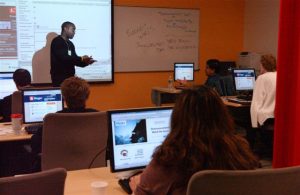Imagine students in your online or remote courses sitting at home, alone, at night, working on your course. If they are confused, they may email you and wait for a reply. On the other hand, recall how you actively clarify misconceptions about an assignment while teaching in person. You can create a similar kind of teaching presence in your Blackboard site by weaving three elements into every page: voice, orienting statements, and transitions. Professors use these elements so naturally when teaching in person that they may not even be aware of them, yet in a Blackboard site, these elements can mean the difference between a student feeling alone and confused or actively supported.
Voice
The first element is voice. Writing in a dry, formal tone may work in academic papers, but it is demotivating to your students. An English professor once said that what you think when you write comes through in your writing, and it’s true. Use this to your advantage. Write as if you are teaching one of your favorite classes or talking to one or two favorite students in your office. When you do, the animation you feel when teaching in person will come through in your writing. Students will “hear” your voice. Imagine you are teaching, and the words will flow.
Orienting Statements
The second element is orienting statements. Guide your students every step of the way, just as you do so naturally when teaching in person. It takes just a sentence or two to orient students to the task ahead.
Professors don’t make a habit of walking into class, throwing a handout at students, and saying, “Here, read this,” or throwing a video up on the screen and saying, “Watch this.” I am sure you can think of plenty of reasons why that practice is inadequate. No one teaches that way in person, yet it is too easy to place links without instructions on your course site.
Introduce everything. Add a sentence or two of instructions before every link, article, website, video, or any element of your course. Imagine what you would say in class and write similar instructions. The result is that students know what you want them to do and why before they click.
Transitions
The third element is transitioning statements. They are the flipside of orienting phrases. Transitions move students from one activity to the next. When you teach in person, notice how naturally you use transitioning statements to keep students’ attention and move them into each new phase of the class period. Chances are you do it so naturally that you are not even aware. In your Blackboard site, transitioning statements have a similar effect of keeping students’ attention. Written in your voice, it’s as if you are speaking through the computer screen directly to each student.
Voice, orienting statements, and transitions – when all three come together, students feel as if the professor is sitting beside them, talking them through the course site.

